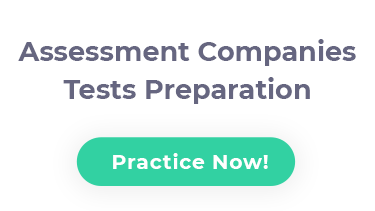People Test Logic Online Preparation & Free PTL Practice Questions [2025]

The People Test Logic (PTL) is an intelligence and skills assessment developed by People Test Systems, primarily used in Denmark. It aims to evaluate candidates’ cognitive abilities across various domains, providing insights into their problem-solving strategies and overall mental capacity.
What Are the Test Structure and the Content of the PTL Test?
The People Test Logic (PTL) is designed to assess a candidate’s cognitive capabilities through a series of 80 multiple-choice questions that must be completed within 30 minutes. These questions are split into three major categories, each targeting a different aspect of cognitive function that is highly relevant to job performance in various sectors, especially for positions requiring leadership, strategic decision-making, or technical problem-solving skills.
- Logical Reasoning Questions:
Logical reasoning tests are used to evaluate a candidate’s ability to think abstractly and identify patterns. In real-world contexts, this might reflect how well someone can troubleshoot problems or identify inefficiencies in complex systems. For example, identifying patterns in a series of shapes or deducing the next logical step in a series helps employers gauge how a candidate processes information and makes decisions without relying on pre-existing solutions. This type of reasoning is crucial for roles in operations, finance, and project management, where thinking outside the box is often necessary to solve unexpected challenges.
- Numerical Reasoning Questions:
Numerical reasoning questions focus on assessing a candidate’s proficiency with numbers, data interpretation, and the ability to apply mathematical concepts to real-world scenarios. These questions are vital for roles that require analysis and decision-making based on numerical data, such as finance, engineering, or data analytics positions. Tasks might involve interpreting graphs, completing numerical sequences, or applying mathematical principles to solve problems. The ability to quickly interpret and manipulate data under time pressure is a key skill for success in these fields.
- Verbal Reasoning Questions:
Verbal reasoning questions are designed to evaluate linguistic and analytical abilities, assessing how well a candidate understands and processes written information. Candidates may be asked to identify word meanings, analyze written passages, or solve word-based analogies. This type of reasoning is essential in roles where communication and comprehension are paramount, such as in legal, marketing, consulting, or editorial fields. By assessing verbal reasoning, employers ensure that candidates have the cognitive flexibility to handle complex documents, policies, and verbal communication in fast-paced work environments.
Purpose and Application
The PTL is primarily used to assess the cognitive abilities of senior managers, leaders, and employees in white-collar positions. It provides a detailed profile of a candidate’s intelligence and logistical competencies across nine distinct areas:
- Decision Speed
- Correct Reasoning
- Logical Perception
- Logical Thinking
- Complex Differentiation
- Mathematical Proficiency
- Linguistic Proficiency
- Learning Capability
- Intelligence Quotient (IQ)
These areas collectively offer a comprehensive understanding of a candidate’s problem-solving abilities and overall cognitive strengths.
Typical Applicants for the People Test Logic
The People Test Logic is used by organizations to assess candidates for roles requiring strong cognitive abilities, problem-solving skills, and critical thinking. It’s commonly part of the hiring process for leadership, management, and technical positions in industries like finance, consulting, IT, and engineering. Notable organizations, including Handelsbanken, Novo Nordisk, and Mediq, rely on PTL to assess potential candidates for senior roles, recognizing the value of cognitive strengths in decision-making and leadership. The test helps identify individuals who can handle complex tasks, make informed decisions, and solve problems quickly—skills that are critical for navigating high-pressure environments.
In many fields, particularly fast-paced industries like consulting or tech, quick thinking and the ability to process large amounts of information efficiently are crucial. Take the case of a senior consultant: the test measures how well the candidate can work through complex, abstract problems in a limited time—skills that are necessary when managing client expectations or providing strategic advice in dynamic situations. A candidate shared with us, “The test was challenging, but it really showed me where I stand in terms of my problem-solving skills. It made me realize that how quickly I can process information matters just as much as what I know.”
From an HR perspective, the test is used to highlight candidates likely to excel in roles requiring both strategic thinking and quick decision-making. For example, in the financial sector, where data-driven decisions can directly affect the company’s performance, fast, accurate numerical reasoning is essential. An HR manager shared with Practice4Me, “We use the People Test Logic to evaluate candidates’ cognitive abilities and their problem-solving approach under time pressure. It’s particularly useful for hiring senior management and technical experts who need to make quick, informed decisions in unpredictable situations.”
Free Example Questions to Practice
- Choose the next pattern in the series.


- A company’s stock price increased by 12% in the first quarter, then decreased by 8% in the second quarter, and rose again by 15% in the third quarter. If the initial price was €120, what is the price after three quarters (rounded to the nearest cent)?
- €142.56
- €139.82
- €144.00
- €136.62
- A machine fills 60 bottles in 8 minutes. A second machine is 25% faster. If both machines work together, how many bottles can they fill in 12 minutes?
- 198
- 204
- 210
- 216
- An investor divides €10,000 among three funds: 40% in Fund A, 35% in Fund B, and the rest in Fund C. Fund A earns 5%, Fund B loses 2%, and Fund C gains 10%. What is the total profit/loss after one year?
- €380 gain
- €350 gain
- €290 gain
- €310 gain
- What is the missing number in the series?
3, 9, 6, 18, 15, 45, ?
- 90
- 30
- 54
- 42
- The following conclusion is based on which assumption:
- Sophie spent weeks preparing thoroughly for the job interview.
- Sophie did not receive a job offer.
- Sophie must not have been a good cultural fit for the company.
- Sophie answered all technical questions correctly.
- Sophie met all the listed qualifications for the position.
- Cultural compatibility is a factor employers consider when making hiring decisions.
- Sophie had relevant past experience.
- No athletes are lazy. All runners are athletes. What must be true?
- All runners are lazy.
- No runners are lazy.
- Some athletes are lazy.
- None of the above.
- The experiment was deemed ____ because the results could not be replicated.
- Innovative
- Groundbreaking
- Lengthy
- Flawed
- What does “meticulous” mean?
- Careless
- Thorough
- Fast
- Messy
- Which word is spelled correctly?
- Accomodate
- Acommodate
- Accommodate
- Acomodate
- Choose the synonym for “vivid”:
- Dull
- Clear
- Dark
- Silent
- Choose the sentence with correct punctuation:
- Lets eat, Grandma!
- Lets eat Grandma!
- Let’s eat Grandma!
- Lets’ eat, Grandma!
Answers:
- B
- A
- B
- A
- D
- C
- B
- D
- B
- C
- B
- C
How to Prepare for the People Test Logic
To perform well on the People Test Logic, it’s essential to practice under realistic, time-constrained conditions. Many candidates find that time pressure adds significant stress. One applicant mentioned, “I didn’t realize how much the clock would add to the challenge. I was good at solving the problems, but I found myself rushing toward the end.”
To avoid this stress and perform your best, make time management a priority in your preparation. Practice regularly under timed conditions to get comfortable with the pace. This helps improve both speed and accuracy, allowing you to approach the test with confidence and clarity. As one senior HR professional put it, “Candidates who practice under timed conditions perform better because they’ve learned to manage their time and stress, which is just as important as solving the problems themselves.”
By familiarizing yourself with the test’s question types—numerical, logical, and verbal—and regularly testing yourself under time pressure, you’ll be better prepared for the real exam and reduce the stress of the timed challenge.



